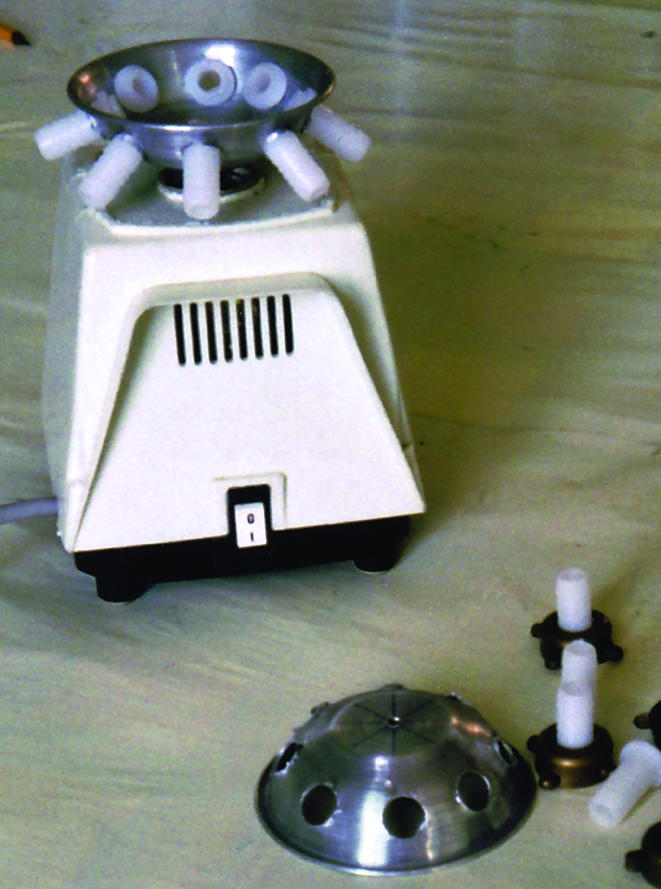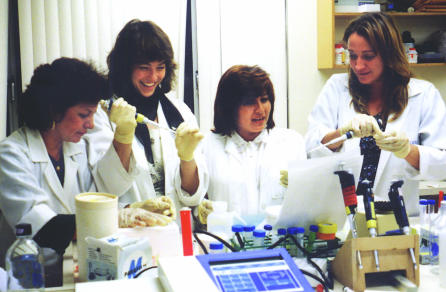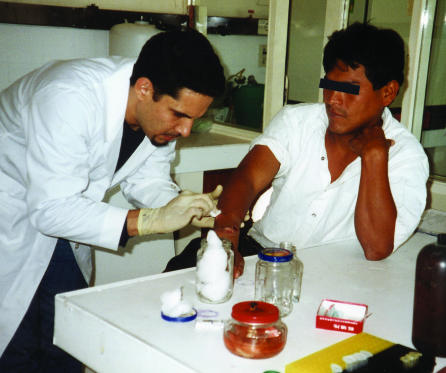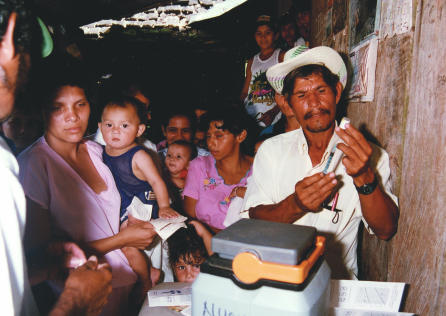Summary
Simply transferring knowledge and instrumentation is not enough to help developing countries build their own research base. Such efforts must be tied to national and local needs to create trust and services for society in the long term
The phrases 'technology transfer' and 'scientific capacity building' are two of the many used to describe scientific partnerships between developed and developing countries. This is an extremely rich and fascinating process that is very complex and often oversimplified. It is undoubtedly an essential interaction. The Global Forum for Health Research report (Global Forum for Health Research, 1999, p126) emphasized the importance of scientific research, stating that 'Strengthening research capacity in developing countries is one of the most effective and sustainable ways of advancing health and development in these countries and of helping correct the 10/90 Gap in health research.' The 10/90 Gap refers to the fact that only 5–10% of all global health research funding is directed to research on health problems that affect 90% of the world's population, and only a small proportion of this funding actually goes to researchers in developing countries.
In most low-income countries, research is a luxury owing to economic constraints, and many scientists hold several other jobs
This essay, written from the perspective of 15 years of collaborative work on infectious disease diagnostics and research with colleagues in Central and South America (Harris et al, 1993; Harris, 1996, 1998; Harris & Tanner, 2000), explores the problems, complexity and excitement of international scientific collaborations to help developing countries establish their own research base. The work described here was done through various frameworks in conjunction with like-minded colleagues in the United States, Europe and Latin America. Initially, it was performed through a volunteer programme that I organized—the Applied Molecular Biology/ Appropriate Technology Transfer (AMB/ATT) Program, then through academic institutions, such as the University of California at San Francisco and Berkeley (California, USA), and finally through a non-profit organization that we founded: the Sustainable Sciences Institute (SSI; www.ssilink.org). Our overarching goal is to help biomedical scientists in underserved communities to gain access to the education, training, funding, information, equipment and supplies needed to diagnose, investigate, prevent and cure infectious diseases. The transfer of knowledge and technology has been brought about through a series of intensive in-country workshops, donations of laboratory supplies and small grants for research projects. So far, 21 workshops have been conducted in 10 Latin American countries, training more than 450 scientists and public-health professionals from 20 developing countries. We have also organized the donations of hundreds of thousands of dollars' worth of laboratory equipment and supplies, and awarded numerous small grants to researchers in these countries.
The first issue that needs to be addressed is the wide range of scientific progress in developing countries. Middle-income countries, such as India, China, Thailand, Brazil, Mexico, Argentina and Chile, to name a few, are actually quite advanced with respect to scientific development, with a national budget for research and numerous PhD programmes. Low-income countries, such as Nicaragua, El Salvador, Ecuador, Bolivia, Haiti and most sub-Saharan African countries, often have neither. In Ecuador, for example, only 0.05% of the national budget is dedicated to research (Wagner et al, 2001), and virtually no PhD programmes are offered in Central America, with the exception of Costa Rica. Most of the work described here has been done in low-income developing countries, which in general are considered 'scientifically lagging' (Wagner et al, 2001), although the main principles of scientific capacity building apply to all international partnerships.
By breaking down technology and reconstituting it on site, one can often achieve what at first seemed impossible, and find simpler ways of performing experiments in the process
There are, of course, numerous challenges to conducting scientific research in developing countries, ranging from limited material and financial resources to poor physical and communication infrastructures. In most low-income countries, research is a luxury owing to economic constraints, and many scientists hold several other jobs. The lack of scientific careers, scientific tradition, institutional support and collaboration within the local scientific community aggravates the problem, along with the fact that available training is often operational in nature rather than research-oriented. However, some of the most intractable challenges are cultural and political issues, exacerbated by the scarcity of resources. Learning to navigate the countries' political situation is crucial, because high-level changes in the Ministry of Health—which tend to occur frequently—can directly affect research projects. Yet it is not only essential but also exhilarating to overcome these obstacles and to succeed eventually in conducting relevant research and in training cadres of scientists in the process. The struggle only makes the success sweeter, and all progress, no matter how small, is a big step forward.
Technology is the bedrock of scientific investigation, and numerous frustrating—and at times amusing—obstacles arise when performing experiments under 'resource-constrained conditions'—the latest in an endless series of euphemisms used to describe the difficult environment found in most developing countries' laboratories. Making scientific tools available in such situations necessitates a fundamental analysis of the technical requirements, which then leads to clever adaptations of equipment, the use of alternative techniques, simplification of protocols and reliance on recycling. The impediments we encounter range from the mundane to the sublime, and foster the most ingenious innova- tions imaginable. Take, for example, the 'blenderfuge' invented by Bolivian investigator Nataniel Mamani, which combines a blender, an aluminium bowl and water-tap adapters to create a microcentrifuge (Fig 1; Harris, 1998). Or his turntable shaker, where the circular rotation of a record player was transformed into a horizontal shaker for the lab (Harris, 1998). Less fanciful but necessary adaptations include voltage stabilizers and circuit breakers for −70 °C freezers and other equipment, which are not designed for the drastic power surges and constant high temperatures found in many tropical countries. Being on good terms with a mechanical engineer is also strongly recommended. On this count—as on many others—the visiting scientists from the developed country generally learn much more from their developing country collaborators than the other way around.
Figure 1.

The Bolivian 'blenderfuge' is an example of innovative ways to overcome equipment scarcity (designed and built by course participant Nataniel Mamani). Photo credit: Nataniel Mamani
By breaking down technology and reconstituting it on site, one can often achieve what at first seemed impossible, and find simpler ways of performing experiments in the process. The key, however, is to understand the principles behind the technique, as well as its limitations. For example, in the absence of a thermocycler, polymerase chain reactions (PCRs) can still be performed with water baths set at the appropriate temperatures, as long as one understands the principle of nucleic acid amplification—except of course, when one attempts to perform manual cycling with a 94 °C water bath in Quito, Ecuador, or La Paz, Bolivia, where water boils at 89 or 80 °C, respectively, because of the high altitude (Fig 2; Harris, 1996). When a proper cold chain to preserve clinical specimens is not available, blood or other samples can be collected on filter paper, dried and then transported at room temperature to the laboratory for subsequent elution of DNA or antibodies for analysis. Numerous other shortcuts can be taken to simplify nucleic acid extraction, once one understands that the principle consists of liberating nucleic acids, separating them from proteins and protecting them from degradation. In many instances, simple procedures based on boiling or silica-particle extraction can work as well as much more complicated protocols (Harris, 1998). Numerous reagents and assays can be produced inhouse instead of relying on expensive kits, as long as quality control is maintained by using multiple controls. Many of these adaptations lead to methodologies that cost less and are also environmentally friendlier.
Figure 2.
The author (second from left) teaching participants sample extraction in preparation for PCR in a workshop in Ecuador. Photo credit: Alejandro Belli
However, building scientific capacity is much more than just technology transfer. Technical aspects are, of course, fundamental, but it is a mistake to regard the process as mere training in laboratory skills. In our view—at least in the area of infectious disease research—laboratory techniques should be taught alongside epidemiological skills to provide a framework that helps researchers using new diagnostic or strain-typing assays to understand local disease patterns and design effective interventions. In all areas of science, however, grant-writing skills are invaluable. We therefore structure our workshops to include training in laboratory, epidemiology and proposal development skills. This includes instruction on ethical review processes and training in how to prepare human-subject protocols and letters of consent.
Similarly, another area often overlooked is manuscript writing. Publication in peer-reviewed journals greatly increases the visibility and acceptability of research in developing countries and boosts the chances of obtaining funding. However, English 'scientese' is not every scientist's native language (Netzel et al, 2003). Similarly, it is not easy to decipher the hidden 'codes' regarding which journal to target, how to compose a cover letter, how many figures to include and how to structure the discussion. To help with these issues, SSI conducts manuscript-writing workshops, the first of which took place in Panama last July with participants from eight Latin American countries. It was received with great enthusiasm by the participants and also engendered much interest from international agencies, such as the Pan American Health Organization, the Central American NeTropica (Network for Research and Training in Tropical Diseases) and the American Association for the Advancement of Science. After lectures in the mornings, each participant worked with a mentor to transform their data into a publishable manuscript. These skills are crucial for a scientific career, because advancement and scientific stature are evaluated primarily by the number and quality of publications in peer-reviewed journals. Lastly, financial and personnel management are crucial skills that scientists must learn. Thus, scientific training should be viewed in a broad sense, encompassing all the skills necessary to be a successful scientist, including those that reach beyond the laboratory bench.
Learning from researchers who are working successfully under similarly resource-constrained conditions engenders trust and greater empowerment for workshop participants, who realize that their obstacles are not insurmountable or unique
Technology alone is not a magic bullet. Existing technologies can be adapted where necessary, and new technologies can be invented when indicated, but the key to scientific success resides in human resources. The emphasis must therefore be on training in an equitable, respectful way and on establishing long-lasting, sustainable partnerships. The knowledge transfer process itself can be broken down into short-term and long-term goals. For example, for workshops to be successful in the short term, and they should be participatory, hands-on and responsive to local initiative, and they should promote equity among instructors and participants, include local and regional experts as instructors and use plenty of regional illustrations. One approach we have found to be extremely effective is 'South–South' transfer, where workshop instructors are almost entirely from developing countries in the region. Learning from researchers who are working successfully under similarly resource-constrained conditions engenders trust and greater empowerment for workshop participants, who realize that their obstacles are not insurmountable or unique. This also creates a multiplier effect by training local instructors at each of the workshops, who then provide further training at future 'peer-trained' workshops as well as informal training in their home institutions.
...being responsive to actual needs increases the likelihood that the methods will be used, as does integration into national networks and infrastructures
However, to achieve long-lasting success, the technology and know-ledge transferred must be carried on beyond the workshops to research projects. For this, long-term technical, scientific and material support is necessary, as is access to electronic communication and resources, and partnerships with local institutions and with more developed countries. Whereas international collaborations are eagerly sought, local inter- institutional or even intra-institutional partnerships are notoriously difficult to establish, in part because of scarcity of resources as well as local politics. Research groups often operate in isolation, limiting the scope and success of their work, and develop collaborative projects only when strongly encouraged. For instance, we have found it necessary at times to make local collaborations a precondition for hosting our workshops or receiving SSI funding. Another key element is the availability of small grants to enable researchers to apply the new tools and knowledge that they obtained during the training programme. The data generated from these projects strengthen subsequent grant applications and help to establish credibility and to make the case for additional funding. SSI runs a small-grants programme that funds selected scientifically meritorious proposals generated during the workshops. Importantly, we have found that the workshops engender awareness and enthusiasm for research at local and national levels that simply did not exist before. By introducing scientific research in the context of locally relevant topics and by providing specific tools, such as grant-writing skills and mentoring, the programme acts as a catalyst for participants to develop their own research projects and initiate their search for funding. Despite overwhelming economic and social pressures, many of our trainees have persevered in science and have been able to perform research studies successfully and to obtain funding from national and international agencies.
Clearly, 'parachute science', in which investigators from developed countries merely collect samples, return home and publish papers, is of no real use to scientists and citizens in developing countries
Even more significant than successful research, in our opinion, is to take the project beyond publications to public health practice and/or implementation at local and national levels. This may be more straightforward in infectious disease research than in certain basic science disciplines, but it bears emphasis. In numerous instances, our colleagues in developing countries have standardized and implemented techniques introduced in workshops, such as the detection and characterization of Leishmania (Fig 3) or dengue virus, and have used the knowledge gained through their training to develop additional assays on their own initiative, for instance for the detection of Chlamydia, Leptospira, Mycobacterium tuberculosis, hepatitis C virus and enteroviruses. In general, being responsive to actual needs increases the likelihood that the methods will be used, as does integration into national networks and infrastructures. As an example, the programme described here was initiated 15 years ago in Nicaragua to develop better diagnosis of the parasitic disease leishmaniasis and improved typing of the parasites. Despite intermittent electricity and a lack of running water on most days of the week, we successfully used PCR to detect and speciate Leishmania parasites, and at the same time introduced Nicaraguan scientists to molecular biology. Collaboration with the Department of Parasitology at the Ministry of Health resulted in a simplification of PCR techniques for the diagnosis of leishmaniasis, and these have been used routinely in Nicaragua for more than a decade (Belli et al, 1998). This work then led to the discovery of a new form of disease caused by Leishmania chagasi infection in Nicaragua (atypical cutaneous leishmaniasis; ACL) (Harris et al, 1998; Belli et al, 1999), spawning further research and training in parasitology and cellular immunology. This research also fostered the production of informational posters about ACL that were distributed throughout the nation's health centres, and increased government purchase of the therapeutic agent glucantime, thereby making treatment more readily available. Thus, our project had a positive influence on both research and public health (Fig 4).
Figure 3.
Taking a specimen for PCR from a lesion of suspected leishmaniasis during a workshop in Bolivia. Photo credit: Eva Harris
Figure 4.
Health workers in a village in Nicaragua. Photo credit: Alejandro Belli
In the area of infectious diseases, we have found that through actively supporting collaborative projects, durable links were forged and maintained between laboratory, clinical, epidemiological and health policy sectors, resulting in tangible health benefits. For instance, after the large and unexpected dengue epidemic in 1999–2000 caught national health authorities in Paraguay off guard, SSI trained scientists in molecular and virological techniques for the detection and characterization of dengue virus. The subsequent implementation of these methods and the close collaboration between the National University and the Ministry of Health established an active surveillance system that led to the rapid identification of dengue virus type 2 in 2001 in the capital city of Asunción, to mobilization of mosquito control activities and to containment of the outbreak. This same experience was repeated in 2002 with the rapid containment of dengue virus type 3 outbreaks, which had spread from an explosive epidemic in neighbouring Brazil. This has resulted in an unprecedented and long-lived collaboration between researchers at the University and epidemiologists and entomologists at the Ministry of Health.
Another illustration of long-term international partnerships is the fruitful collaboration that has been maintained with the Department of Virology at the Ministry of Health in Nicaragua over the past eight years. The initial goal was to strengthen laboratory capacity and improve the epidemiological surveillance of dengue at a national level. Dengue is the most prevalent mosquito-borne viral illness in humans and a major public health problem worldwide—particularly in the Americas and Asia—and it has been a growing problem in Nicaragua since 1985. The National Virology Laboratory in Nicaragua is now fully capable of performing the techniques necessary to detect and characterize dengue virus, and has established itself as a centre of excellence in Central America for dengue diagnosis, epidemiology and research. A 1995 epidemic of acute febrile illness was successfully managed, owing in large part to scientists who were able to rule out dengue virus as the cause, on the basis of the knowledge they had acquired through our training. Subsequently, a longitudinal hospital-based study was conducted to investigate risk factors for severe dengue. This resulted in novel epidemiological findings and led to the establishment of a productive collaboration between laboratory, epidemiology and clinical sectors of the health system that have traditionally worked in isolation (Harris et al, 2000). The Ministry of Health recently adopted the study design as the foundation for a national sentinel site surveillance system. Numerous other virological and epidemiological projects have been performed (Balmaseda et al, 1999; Harris et al, 1999, 2003). For example, non-invasive specimens such as saliva have been shown to be alternative options for the diagnosis and serosurveillance of dengue (Balmaseda et al, 2003). Additionally, a recent entomological survey unexpectedly led to the discovery of a second dengue virus-transmitting mosquito, Aedes albopictus, in a major urban centre in Nicaragua. Current field projects are focused on using serological and entomological evidence together with proven epidemiology methods to motivate community participation in mosquito control, as the only avenue available to prevent and control dengue.
One major point worth emphasizing is that true international partnerships require a huge investment of time from all participants—and are hugely rewarding in return. Clearly, 'parachute science', in which investigators from developed countries merely collect samples, return home and publish papers, is of no real use to scientists and citizens in developing countries. However, for the most part, teaching, mentorship and collaborations are not part of the institutional reward system in developed and middle-income countries, because tenure committees and funding agencies look only at the principal investigator of a grant and the first or last author on a publication. SSI is often called upon by groups in developed or middle-income countries that have the expertise to conduct training or workshops but lack the incentive to do so. Thus, in more developed countries, the value of teaching and mentorship needs to be underscored, and institutional reward systems that encourage international partnerships must be established. On the brighter side, there are numerous examples of thriving 'North–South' collaborations, even though the investment of time often comes at the expense of the investigators on both sides.
Last but not least, building scientific capacity is in every way a two-way street. One hopes that scientists from developed countries can contribute to their colleagues in developing countries in terms of knowledge, technologies and resources, but there is much to be gained from the flow in the other direction. Local expertise and local knowledge of diseases are invaluable, as are the tremendous fountains of innovation at all levels. Personal resilience and life perspective are only some of the profoundly moving and inspirational elements that accompany international scientific partnerships—not to mention the wonderful collaborations and lifelong friendships that emerge from this truly transformative experience.

Acknowledgments
I thank all my friends and colleagues worldwide who have made this work not only possible but inspirational. I thank J. Coloma, N. Sager, S. Hammond and D. Kaisel for helpful comments.
References
- Balmaseda A, Sandoval E, Pérez L, Gutiérrez CM, Harris E (1999) Application of molecular typing techniques in the 1998 dengue epidemic in Nicaragua. Am J Trop Med Hyg 61: 893–897 [DOI] [PubMed] [Google Scholar]
- Balmaseda A et al. (2003) Diagnosis of dengue virus infection by detection of specific immunoglobulin M (IgM) and IgA antibodies in serum and saliva. Clin Diagn Lab Immunol 10: 317–322 [DOI] [PMC free article] [PubMed] [Google Scholar]
- Belli A, Rodriguez B, Avilés H, Harris E (1998) Simplified PCR detection of New World Leishmania from clinical specimens. Am J Trop Med Hyg 58: 102–109 [DOI] [PubMed] [Google Scholar]
- Belli A, Garcia D, Palacios X, Rodriguez B, Valle S, Tinoco E, Marin F, Harris E (1999) Leishmania chagasi causes widespread atypical cutaneous leishmaniasis in Nicaragua. Am J Trop Med Hyg 61: 380–385 [DOI] [PubMed] [Google Scholar]
- Global Forum for Health Research (1999) 10/90 Report on Health Research 1999. World Health Organization, Geneva, Switzerland [Google Scholar]
- Harris E (1996) Developing essential scientific capability in countries with limited resources. Nature Med 2: 737–739 [DOI] [PubMed] [Google Scholar]
- Harris E (1998) A Low-Cost Approach to PCR: Appropriate Transfer of Biomolecular Techniques. Oxford University Press, New York, USA [Google Scholar]
- Harris E, Tanner M (2000) Health technology transfer. Br Med J 321: 817–820 [DOI] [PMC free article] [PubMed] [Google Scholar]
- Harris E, Kropp G, Belli A, Rodriguez B, Agabian N (1998) Singlestep multiplex PCR assay for characterization of New World Leishmania complexes. J Clin Microbiol 36: 1989–1995 [DOI] [PMC free article] [PubMed] [Google Scholar]
- Harris E, López M, Arévalo J, Bellatin J, Belli A, Moran J, Orrego O (1993) Short courses on DNA detection and amplification in Central and South America: the democratization of molecular biology. Biochem Educ 21: 16–22 [Google Scholar]
- Harris E et al. (2003) Fluid intake and decreased risk for hospitalization for dengue fever, Nicaragua. Emerg Infect Dis 9: 1003–1006 [DOI] [PMC free article] [PubMed] [Google Scholar]
- Harris E, Sandoval E, Xet-Mull AM, Johnson M, Riley LW (1999) Rapid subtyping of dengue viruses by restriction sitespecific (RSS)-PCR. Virology 253: 86–95 [DOI] [PubMed] [Google Scholar]
- Harris E et al. (2000) Clinical, epidemiologic, and virologic features of dengue in the 1998 epidemic in Nicaragua. Am J Trop Med Hyg 63: 5–11 [DOI] [PubMed] [Google Scholar]
- Netzel R, Perez-Iratxeta C, Bork P, Andrade MA (2003) Countryspecific variations of the English language in the biomedical literature. EMBO Rep 4: 446–451 [DOI] [PMC free article] [PubMed] [Google Scholar]
- Wagner CS Brahmakulam I, Jackson B, Wong A, Yoda T (2001) Science and technology collaboration: Building capacity in developing countries? Rand Publications, Santa Monica, California, USA





